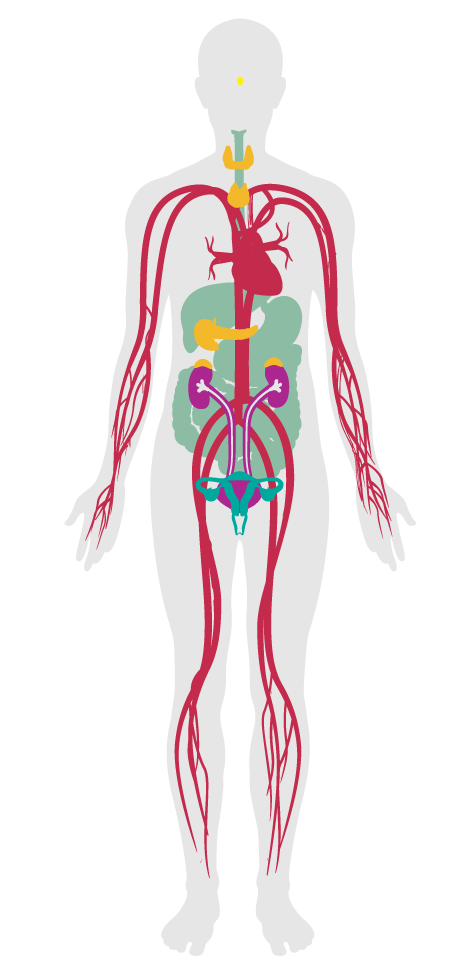Processed foods
- 38 Fruits and vegetables
- 39 Processed foods
- 40 Food allergies
- 41 Hand washing
- 42 Food contamination
- 43 Artificial ingredients
- 44 Nutritional information
- 45 Food advertising
- 46 Safe food preparation materials
- 47 Serving sizes
- 48 Special diets
- 49 Responsible food production
- 50 Food storage
- 51 Food production
- 52 Mindful eating
- P1 Food environment
- P7 Strategic Dining Design
39. Processed foods
Foods that contain highly processed ingredients tend to be high in sugar, calories and added fats, and have low nutritional value. More than half of the U.S. population consumes sugar-sweetened beverages on a given day, and the average consumption of added sugars is more than 22 teaspoons per day, even though the recommended limit is 6-9 teaspoons. High consumption of added sugars is associated with weight gain, obesity, type 2 diabetes, kidney disease, hypertension and other negative health effects.
This feature prohibits or limits the main components of highly processed and industrialized foods (refined sugars, flours and oils) to encourage the consumption of healthy cuisines.
All foods, beverages, snacks and meals sold or distributed on a daily basis on the premises by (or under contract with) the project owner meet the following conditions:
All foods, beverages, snacks and meals sold or distributed on a daily basis on the premises by (or under contract with) the project owner do not contain:
Oil in deep fryers is discarded before the following condition is met:
Beverages available to elementary and middle school students only include the following:
Beverages sold or distributed to high school students and adults are limited to the following:
All foods sold or distributed in the facility meet the following criteria:

Applicability Matrix
| Core & Shell | New & Existing Buildings | New & Existing Interiors | |
|---|---|---|---|
| Part 1: Refined Ingredient Restrictions | P | P | P |
| Part 2: Trans Fat Ban | P | P | P |
| Part 3: Fryer Oil | - | - | - |
| Part 4: Beverages for Elementary and Middle School | - | - | - |
| Part 5: Beverages for High School and Adult Education | - | - | - |
| Part 6: Ingredients Restrictions for Schools | - | - | - |
| Commercial Kitchen | Education | Multifamily Residential | Restaurant | Retail | |
|---|---|---|---|---|---|
| Part 1: Refined Ingredient Restrictions | - | - | O | P | P |
| Part 2: Trans Fat Ban | - | P | O | P | P |
| Part 3: Fryer Oil | P | - | - | - | - |
| Part 4: Beverages for Elementary and Middle School | - | P | - | - | - |
| Part 5: Beverages for High School and Adult Education | - | P | - | - | - |
| Part 6: Ingredients Restrictions for Schools | - | P | - | - | - |
Verification Methods Matrix
| Letters of Assurance | Annotated Documents | On-Site Checks | |
|---|---|---|---|
| Part 1: Refined Ingredient Restrictions | Operations Schedule | Spot Check | |
| Part 2: Trans Fat Ban | Operations Schedule | Spot Check | |
| Part 3: Fryer Oil | Policy Document | Performance Test | |
| Part 4: Beverages for Elementary and Middle School | Architect | Operations Schedule | Spot Check |
| Part 5: Beverages for High School and Adult Education | Architect | Operations Schedule | Spot Check |
| Part 6: Ingredients Restrictions for Schools | Architect | Operations Schedule | Spot Check |
| 39.1.d |
The AHA's Whole Grains and Fiber fact sheet identifies whole grains as good source of fiber and nutrients. |
| 39.6.c |
The American Heart Association notes that "eating whole grains provides important health benefits". |
| 39.2.a |
The CDC Trans Fat: The Facts identifies partially hydrogenated oils as a source of trans fats that should be avoided. |
| 39.6.b |
The Dietary Guidelines for Americans provides suggestions for consumers relating to caloric intake, including potential strategies such as avoiding foods with the word "fried" when eating out. |
| 39.1.b |
The CDC's Guide to Strategies for Reducing the Consumption of Sugar-Sweetened Beverages identifies that limited access to sugar sweetened beverages can decrease their consumption and increase consumption of healthier beverages. |
| 39.1.c |
The CDC's Guide to Strategies for Reducing the Consumption of Sugar-Sweetened Beverages identifies that limited access to sugar sweetened beverages can decrease their consumption and increase consumption of healthier beverages. |
| 39.1.a |
The CDC's Guide to Strategies for Reducing the Consumption of Sugar-Sweetened Beverages identifies that limited access to sugar sweetened beverages can decrease their consumption and increase consumption of healthier beverages. |
| 39.3.a |
The BC Centre for Disease Control presents guidelines that state that frying oil should be changed when the level of Total Polar Materials (Polar Content) is greater than 24%. |
| 39.4.a |
The IOM's Nutrition Standards for Foods in Schools classifies "water without flavoring, additives, or carbonation" as a tier 1 beverage for all students. |
| 39.4.b |
The IOM's Nutrition Standards for Foods in Schools includes low-fat, nonfat, lactose-free and soy milk in 8 ounce portions under their classifications for tier 1 beverages. It also includes flavored milk with up to 22 grams of sugar per 8 ounce portion. |
| 39.4.c |
The IOM's Nutrition Standards for Foods in Schools classify 100% fruit juice in 4 ounce portions as a tier 1 beverage for elementary and middle school students. |
| 39.5.b |
The IOM's Nutrition Standards for Foods in Schools classifies low-fat, nonfat, lactose-free and soy milk as tier 1 beverages for all students. It also includes flavored milk with up to 22 grams of sugar per 8 ounce portion for all students. |
| 39.5.c |
The IOM's Nutrition Standards for Foods in Schools recommends beverages with no more than 35% of calories from sugar but allows some exceptions, including 100% fruit or vegetable juices without added sugars. |
| 39.5.a |
The IOM's Nutrition Standards for Foods in Schools classifies unflavored water, non-carbonated water, and water without additives as a tier 1 beverage for all students. |
| 39.6.a |
The IOM's Nutrition Standards for Foods in Schools recommends that "snacks, foods, and beverages provide no more than 35% of calories from total sugars per portion as packaged", except for 100% fruits and vegetables. |
| 39.6.e |
The IOM's Nutrition Standards for Foods in Schools generally do not recommend foods with more than 35% of calories from sugar per portion, but as an exception allow nonfat and low-fat yogurts with up to 30 grams of sugar. |
| 39.6.f |
The IOM's Nutrition Standards for Foods in Schools states that beverages with "nonnutritive sweeteners are only allowed in high school after the end of the school day." |
| 39.6.d |
The USDA's Smart Snacks in School sets calorie limits for snack items at less than or equal to 200 calories. |
| 39.6.g |
The USDA's Smart Snacks for Schools provides nutrition standards which are required by the Healthy, Hunger-Free Kids Act of 2010. |
| 39.5.d |
The Harvard T. H. Chan School of Public Health Nutrition Source notes that a threshold of 1 gram of sugar per ounce would be a better threshold for what can be marketed as a "reduced sugar" beverage than what is currently allowed by labeling regulations. |
